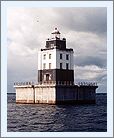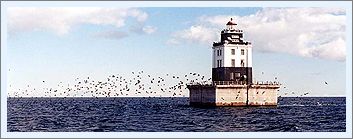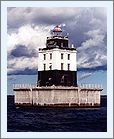|
Historical Information

Poe
Reef lies just eight feet beneath the water's surface between Bois
Blanc Island and the Lower Peninsula mainland, and as such has long
represented a significant hazard to vessels making their way through the
Straits between Lakes Michigan and Huron.
In the early 1890's the Lighthouse
Board faced a vexing problem. Increasing vessel traffic created a
need to install navigational aids at a number of offshore shoals and
reefs. With Congressional funds increasingly difficult to obtain, and
the costs of offshore lighthouse construction prohibitively high, the
Board determined that the use of lightships to mark such hazards would
be both significantly more expeditious and cost effective.
Unable to convince Congress to free up
the funds for these lightships, the Board took the chance of redirecting an
existing $60,000 congressional appropriation for a lighthouse off
Peninsula Point to the purchase of four lightships.
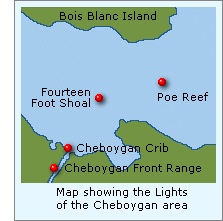 In 1892 two contracts totaling
$55,960 were awarded to the Craig Shipbuilding Company in Toledo for the
construction of four lightships. Designated as Lightships LV59, LV60,
LV61 and LV62, all four vessels were built to similar specifications.
Framed and planked of white oak they measured 87' 2" inches in
length, 21' 6" inches in the beam, with a draft of 8 feet. In a
cost-cutting effort, the vessels were un-powered, outfitted with only a
small riding sail carried on a short after mast. Equipped with a cluster
of three oil-burning lens lanterns hoisted on their foremasts, each was
also equipped with 6" steam whistles and hand-operated bells for
fog use. Work was completed on the four vessels
the following year, and after sea trials, all four were commissioned by
the Board and placed into service, LV59 being assigned to Bar Point,
LV60 to Eleven Foot Shoal, LV61 to Corsica Shoal and LV62 to Poe Reef. In 1892 two contracts totaling
$55,960 were awarded to the Craig Shipbuilding Company in Toledo for the
construction of four lightships. Designated as Lightships LV59, LV60,
LV61 and LV62, all four vessels were built to similar specifications.
Framed and planked of white oak they measured 87' 2" inches in
length, 21' 6" inches in the beam, with a draft of 8 feet. In a
cost-cutting effort, the vessels were un-powered, outfitted with only a
small riding sail carried on a short after mast. Equipped with a cluster
of three oil-burning lens lanterns hoisted on their foremasts, each was
also equipped with 6" steam whistles and hand-operated bells for
fog use. Work was completed on the four vessels
the following year, and after sea trials, all four were commissioned by
the Board and placed into service, LV59 being assigned to Bar Point,
LV60 to Eleven Foot Shoal, LV61 to Corsica Shoal and LV62 to Poe Reef.
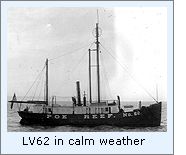 With the words POE REEF brightly
painted in white on her fire engine red hull, LV62 was towed to Poe Reef
by the lighthouse tender Marigold, and anchored on station to begin her
vigil on September 29, 1893. For the next seventeen years LV62 spent
every shipping season faithfully guarding the shoal. With the end of
each shipping season, one of the lighthouse tenders would make the
rounds of all lightship stations in the Straits area, and tow them into
Cheboygan harbor for winter lay-up. While in Cheboygan, necessary
repairs and improvements would be made in preparation for the following
season. At some time in March or April, the ice would break up
sufficiently to allow the vessels to be towed back to their stations to
stand guard for yet another season. With the words POE REEF brightly
painted in white on her fire engine red hull, LV62 was towed to Poe Reef
by the lighthouse tender Marigold, and anchored on station to begin her
vigil on September 29, 1893. For the next seventeen years LV62 spent
every shipping season faithfully guarding the shoal. With the end of
each shipping season, one of the lighthouse tenders would make the
rounds of all lightship stations in the Straits area, and tow them into
Cheboygan harbor for winter lay-up. While in Cheboygan, necessary
repairs and improvements would be made in preparation for the following
season. At some time in March or April, the ice would break up
sufficiently to allow the vessels to be towed back to their stations to
stand guard for yet another season.
1910 would be LV62's last season on Poe
Reef, since for reasons we have as yet been unable to determine the
decision was made to trade assignments at Bar Point with LV59. LV59
was delivered to Poe Reef at the beginning of the 1911 shipping season,
remained at the reef for the following three seasons. During a
departmental survey of lightships in the fall of 1914, she was found to
be unseaworthy and thus condemned at the end of the season. To replace
her, LV96 was repainted with POE on her sides, and transferred from
Buffalo to Poe Reef at the beginning of the 1915 navigation season.
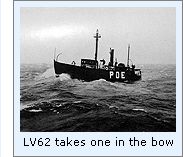 Built by Racine-Truscott-Shell Lake
Boat Company in Muskegon in 1914 at a total cost of $71,292, LV96 had
only seen one year of service at her Buffalo station before her
transfer. 101' 6" in length, 23' 6" in beam and drawing 9'
5", she was constructed of steel in the whaleback design, with her
pilot house forward. Equipped with electrical generators and batteries
powered by two 3-cylinder kerosene engines, she displayed a large
cylindrical lantern housing with a thousand-candlepower electric lamp. A
revolving parabolic reflector provided her with a unique light
signature. A six-inch air siren, submarine bell and a hand operated bell
made her presence known whenever fog shrouded the reef. Built by Racine-Truscott-Shell Lake
Boat Company in Muskegon in 1914 at a total cost of $71,292, LV96 had
only seen one year of service at her Buffalo station before her
transfer. 101' 6" in length, 23' 6" in beam and drawing 9'
5", she was constructed of steel in the whaleback design, with her
pilot house forward. Equipped with electrical generators and batteries
powered by two 3-cylinder kerosene engines, she displayed a large
cylindrical lantern housing with a thousand-candlepower electric lamp. A
revolving parabolic reflector provided her with a unique light
signature. A six-inch air siren, submarine bell and a hand operated bell
made her presence known whenever fog shrouded the reef.
In the spring of 1921, LV96 was
reassigned to duty on Corsica Shoal in Lake Huron and the newly
commissioned LV99 was delivered to Poe Reef in her place.
LV99 had her keel laid in June of 1919
at Rice Brothers in Boothbay Harbor, Maine, and work was well underway
on July 10 when a fire gutted the structure. With new materials
procured, the vessel was completely rebuilt at a total cost $97,220, and
she was launched on November 7 of that same year. 91' 8" in length,
with a beam of 22' she drew 10' 7" and was powered by a
single-cylinder 125hp steam engine. Displaying a single acetylene lens
lantern, she was also equipped with a ten-inch steam whistle and a hand
operated bell.
As part of a series of a significant
offshore light construction projects being undertaken in the Straits
area in the late 1920's, the Lighthouse Service decided to build a
permanent station on Poe Reef in 1927.
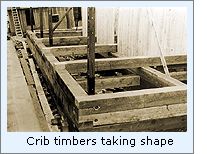 For two years, an 80-man construction
crew had been working out of a base camp on Government Island in Les
Cheneaux Islands, while they undertook the mammoth task of building the
Martin Reef Light. With the completion of that project in the summer of
1927, the entire base camp was loaded onto the lighthouse tenders ASPEN and
MARIGOLD, and rebuilt on the north pier at the mouth of the
Cheboygan River. With establishment of the camp, construction at Poe
Reef Light began on two fronts. For two years, an 80-man construction
crew had been working out of a base camp on Government Island in Les
Cheneaux Islands, while they undertook the mammoth task of building the
Martin Reef Light. With the completion of that project in the summer of
1927, the entire base camp was loaded onto the lighthouse tenders ASPEN and
MARIGOLD, and rebuilt on the north pier at the mouth of the
Cheboygan River. With establishment of the camp, construction at Poe
Reef Light began on two fronts.
Construction plans called for the
placement of a sixty-four foot square wooden crib on the reef to serve
as a foundation for the pier on which the tower would be constructed. In
order to prepare the reef for the crib's installation, an area first had
to be leveled and cleared of all rocks and boulders. For this task,
Lighthouse Service Scow #1 was equipped with a steam-powered derrick and
a clamshell bucket. Towed out to the reef by the lighthouse tender ASPEN, and anchored at the edge of the reef, hardhat divers assisted in
guiding the scow's clamshell.
Back at the Cheboygan pier with the
construction of a skid way complete, the timbers of the crib itself were
assembled on top of the skid way. Constructed of dressed 12" by
12" timbers, the crib was a sixty-four feet square and featured
tightly crafted half-lap joints throughout in order to provide the
utmost in structural rigidity. With the outer walls constructed in an
elongated brick pattern, each joint was hand-drilled and bolted, and
iron angles added to the corners for even more strength. Finally, the
upper exterior surfaces were sheathed with steel plates protruding six
feet above the sides. These steel plates designed to create the exterior
forms into which the concrete of the pier itself would be poured once
the crib was positioned on the reef.
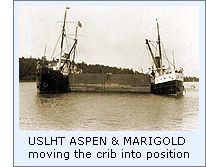 With preparatory work complete on the
reef, the lighthouse tenders ASPEN and MARIGOLD pulled the completed
crib down the skid way, into the water, and thence into the lake to the
reef, where it was carefully positioned over the prepared area on the
reef. Crushed limestone and rocks were then dumped into the crib from a
self-unloading lake freighter until the crib sank to the bottom, resting
on the leveled area of the reef. With the crib completely filled with
limestone and rocks, Scow #1 was outfitted with a gasoline powered
cement mixer, a wooden tower, hopper and discharge chute. With concrete
from the mixer dumped into the hopper, the hopper was raised to the top
of the tower and dumped into the discharge chute. This chute was then
pivoted across the surface of the crib, allowing crewmembers to
distribute the concrete evenly until it was filled to the top of the
steel plates rimming the crib. By virtue of the base camp's location in
Cheboygan, dependent on weather conditions either the Aspen or the
crew's work boat would transport the crew to the reef at the start of
each day's work, returning to transport them back to camp at day's end. With preparatory work complete on the
reef, the lighthouse tenders ASPEN and MARIGOLD pulled the completed
crib down the skid way, into the water, and thence into the lake to the
reef, where it was carefully positioned over the prepared area on the
reef. Crushed limestone and rocks were then dumped into the crib from a
self-unloading lake freighter until the crib sank to the bottom, resting
on the leveled area of the reef. With the crib completely filled with
limestone and rocks, Scow #1 was outfitted with a gasoline powered
cement mixer, a wooden tower, hopper and discharge chute. With concrete
from the mixer dumped into the hopper, the hopper was raised to the top
of the tower and dumped into the discharge chute. This chute was then
pivoted across the surface of the crib, allowing crewmembers to
distribute the concrete evenly until it was filled to the top of the
steel plates rimming the crib. By virtue of the base camp's location in
Cheboygan, dependent on weather conditions either the Aspen or the
crew's work boat would transport the crew to the reef at the start of
each day's work, returning to transport them back to camp at day's end.
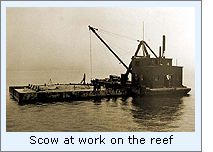 With the final pour to the upper limit
of the steel sheathing, the entire top surface of the concrete was
carefully leveled through the use of a transit. It was critical that
this upper surface be completely plumb, since it was the foundation on
which the pier and the lighthouse itself would stand. Once level was
established, the first of a series wooden forms which had been
prefabricated back at the camp, were attached to the outside of the
structure. As the form for each level was filled with concrete, the next
level of forms was added above. Like a giant puzzle, each form created
different sections of the ladder accesses on each of the four sides, the
arch-topped storage areas within the pier, and finally the wave flare at
the top of the pier. This wave flare was a vital component of the crib's
design, since it was designed to divert waves crashing against the pier,
thus reducing the likelihood of wave action smashing against the tower
itself. With the pouring of the final level, anchoring points for the
light station structure itself and the posts around the outer edge were
cast in place. With the final pour to the upper limit
of the steel sheathing, the entire top surface of the concrete was
carefully leveled through the use of a transit. It was critical that
this upper surface be completely plumb, since it was the foundation on
which the pier and the lighthouse itself would stand. Once level was
established, the first of a series wooden forms which had been
prefabricated back at the camp, were attached to the outside of the
structure. As the form for each level was filled with concrete, the next
level of forms was added above. Like a giant puzzle, each form created
different sections of the ladder accesses on each of the four sides, the
arch-topped storage areas within the pier, and finally the wave flare at
the top of the pier. This wave flare was a vital component of the crib's
design, since it was designed to divert waves crashing against the pier,
thus reducing the likelihood of wave action smashing against the tower
itself. With the pouring of the final level, anchoring points for the
light station structure itself and the posts around the outer edge were
cast in place.
With the setting of this final layer of
concrete, the bunkhouse on the pier in Cheboygan was loaded onto the
Aspen and transported to the reef, where it was lifted onto the pier.
With the construction of a temporary cook shed, the crew was able to
take up residence at the work site, and the workdays grew longer with
the elimination of the daily commute from Cheboygan. The crew's
attention now turned to the construction of the tower itself.
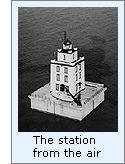 The station building at Poe Reef was to
be an exact duplicate of that which the crew had previously completed at
Martins Reef. The main twenty-five foot square structure consisted of a
steel skeletal framework to which an exterior sheathing of riveted steel
plates was applied. Thirty-eight feet tall, it contained three levels,
or "decks", as the crews assigned to the station knew them.
The two upper decks were set up as living quarters, while the main lower
deck served as housing for the machinery required for powering the
lights, heating system and foghorn. The station building at Poe Reef was to
be an exact duplicate of that which the crew had previously completed at
Martins Reef. The main twenty-five foot square structure consisted of a
steel skeletal framework to which an exterior sheathing of riveted steel
plates was applied. Thirty-eight feet tall, it contained three levels,
or "decks", as the crews assigned to the station knew them.
The two upper decks were set up as living quarters, while the main lower
deck served as housing for the machinery required for powering the
lights, heating system and foghorn.
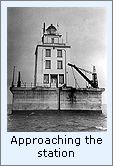 Centered atop the main structure stood
sixteen-foot square, ten-foot high watch room of similar construction,
with a single observation window on each side. Finally, a decagonal cast
iron lantern room was installed on the roof of the watch room, and
outfitted with a Third Order Fresnel
lens. The combination of pier and
tower provided the Fresnel with a seventy-one foot focal plane, and a
visibility range of almost twenty nautical miles in clear conditions.
Work was completed at the station and the light exhibited for the first
time on the evening of August 15, 1929. Centered atop the main structure stood
sixteen-foot square, ten-foot high watch room of similar construction,
with a single observation window on each side. Finally, a decagonal cast
iron lantern room was installed on the roof of the watch room, and
outfitted with a Third Order Fresnel
lens. The combination of pier and
tower provided the Fresnel with a seventy-one foot focal plane, and a
visibility range of almost twenty nautical miles in clear conditions.
Work was completed at the station and the light exhibited for the first
time on the evening of August 15, 1929.
At some point in time, in order to
eliminate the possibility of the Poe Reef Light being mistaken for the
identical all white structure at Martin Reef, the main deck and watch
room of the Poe structure were given a contrasting coat of black paint.
With construction at the reef complete
in late 1929, the bunkhouse and cook shack were loaded back onto the
tender Aspen, and returned to Cheboygan, where the camp was readying to
begin construction of a new light on Fourteen Foot Shoal.
The light was automated in 1974 with
the installation of a solar-powered 375mm acrylic optic.

Keepers of
this Light

Click here
to see a complete listing of all Poe Reef Light keepers compiled by
Phyllis L. Tag of Great Lakes Lighthouse Research.

Finding this
Light

While
a private vessel is undoubtedly the best way to obtain close-up views of
this Light, Sheplers Ferry Service out of Mackinaw City offers a number of lighthouse cruises during the summer season. Their "Eastbound Tour" includes passes by Round Island, Bois Blanc Island, Poe Reef and Fourteen Foot Shoal. For schedules and rates for this tour, visit their website at:
www.sheplerswww.com or contact them at:
PO Box 250
Mackinaw City, MI 49701
Phone (800) 828-6157

References
& Credits

 National Parks Service 1994 Inventory of Historic
Light Stations National Parks Service 1994 Inventory of Historic
Light Stations
Annual reports of the Lake Carrier's Association, various 1914 - 1929
USLHS Bulletin, May 1, 1930
Great Lakes Coast Pilot, NOAA, 2000
Martin Reef - Lightship to Lighthouse, John J. Sellman, 1995
Northern Lights, Charles K. Hyde, 1995
Lightships and Lightship Stations of the United
States Government, Willard Flint, 1989
Keeper listings for this light appear courtesy of Tom & Phyllis Tag
|
